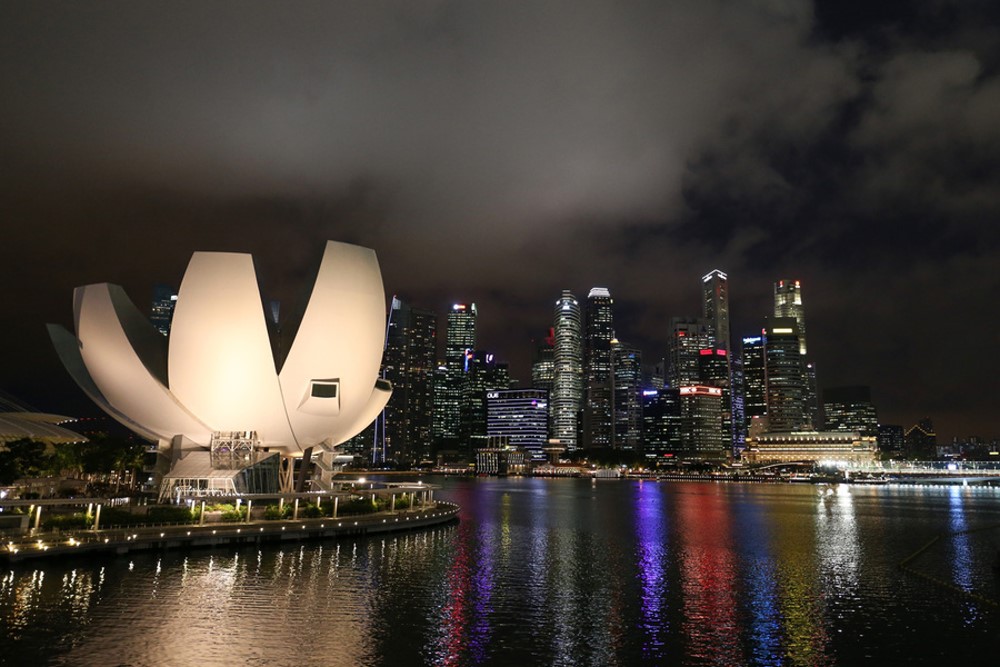Formula 1 News: 2025 Singapore GP at Marina Bay Preview
Formula One racing makes its return to Singapore this coming weekend for the 16th time at the floodlit Marina Bay street circuit for round 18 of the 2025 FIA Formula 1 World Championship, the Singapore Grand Prix.
–by Mark Cipolloni–
After racing on the shores of the Caspian Sea, Formula 1 again tackles a street circuit, this time in the City-State of Singapore, just 140 kilometers North of the equator, the imaginary line that separates the northern and southern hemispheres.
The shift a long way south from Baku means a big change in two elements of the weather, namely humidity and temperature. The former is usually above 70%, while the temperature which remains more or less the same in winter and summer, fluctuates between 24 and 31°C. This makes the Singapore weekend one of the most physically demanding for the drivers, who can lose up to three kilos in weight during the race, aggravated by the twisty nature of the track which offers little respite when at the wheel.
Formula 1 first ventured to Singapore, located off the tip of the Malay peninsula, in 2008. The city state broke new ground as it became the first night race in Formula 1 history, with thousands of lights illuminating a course that navigated its way past some of Singapore’s most illustrious landmarks.
The challenge for teams and drivers is accentuated by the high humidity levels, meaning ice buckets are at the ready after each session, while the distorted time schedule means personnel tend to remain on a European time zone, despite Singapore being located at GMT +8.

The Marina Bay Street Circuit stretches out across 3.07 miles around the bumpy streets of the Lion City, and there are an abundance of short- and medium-speed 90-degree turns, meaning strong traction is a requisite for a quick lap. The removal of four corners in 2023 created another passing place, into turn 16, but the straights remain relatively short, meaning opportunities to overtake can be at a premium. The circuit can also lack grip off-line, while the proximity of the unforgiving walls heightens the challenge for drivers in what is typically one of the longest grands prix of the season due to the slow average lap speed.
Singapore joined Formula 1’s calendar in 2008 with a circuit mapped out around some of the city’s most eye-catching landmarks. Singapore broke new ground as Formula 1’s first night race, with thousands of lights illuminating the course, and the floodlit buildings provide a stunning backdrop to a high-speed pursuit through the city.
Teams and drivers consequently have to manage an unusual timetable, with the race start at 20:00 local, meaning breakfast in mid[1]afternoon, dinner in the early hours, and blackout curtains in hotel rooms essential. Singapore’s high temperatures and humidity levels also adds to the challenge for everyone in the team.
A new 4th DRS zone was added for 2024
There are around seven thousand kilometers separating Baku and Singapore, and the entire Formula 1 circus has just tackled yet another logistical challenge of this very long season, moving personnel, cars and equipment in a matter of a couple of days from the shores of the Caspian Sea to the city-state where the Malacca Straights meet the South China Sea. This is the first time these two races have been run back-to-back.
For the upcoming Singapore Grand Prix this weekend, the FIA has made last-minute changes to the Marina Bay street circuit, with the biggest one being the addition of a fourth DRS zone to the circuit for more overtaking opportunities.
Starting with the changes to the circuit, the pit lane has seen a significant adjustment last year, with the maximum speed reduced from 80 km/h to 60 km/h. This change could substantially affect race strategies, as drivers are expected to lose approximately 28 seconds on average due to the new speed limit.
In 2023, the Marina Bay circuit saw a major overhaul with a new 400-meter straight replacing the former Turns 16-19. In 2024, additional changes included resurfacing at Turns 3, 9, 10, 12, 14, and 17. To enhance overtaking opportunities on this challenging street circuit, a new DRS zone was added between Turns 14 and 16. As a result, Singapore, along with Australia, now features the most DRS zones on the F1 calendar.
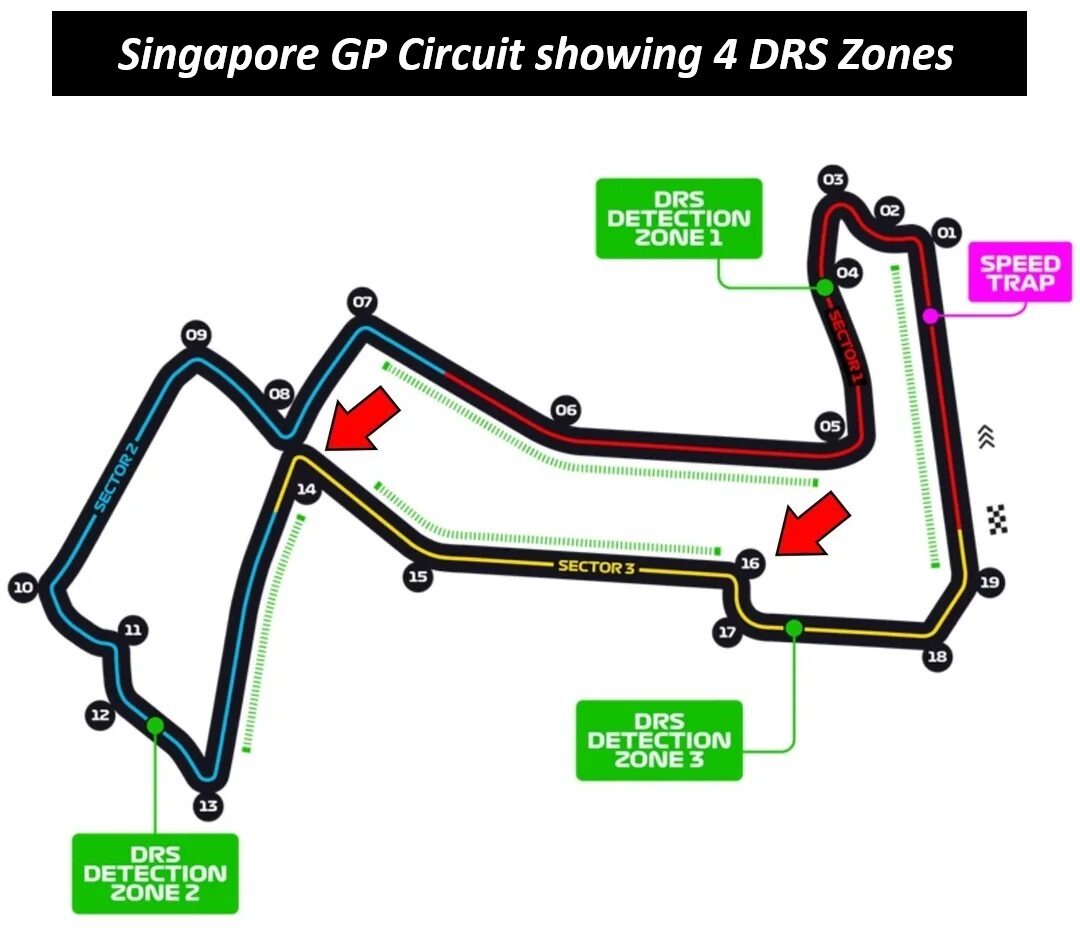
In addition, Pirelli has decided to bring its softest tire to Singapore, starting with the C5 compound as the softest, while C4 will be medium, and C3 will be the hardest of the lot.
The circuit was modified in 2023 with the aim of making it flow better, but it is still one of the twistiest of the season. Its length is now down to 4.940 kilometers, so that the number of laps has been increased to 62. In the final sector, between what used to include turns 16 to 19, a 400-meter straight has replaced them so that the number of corners has been reduced from 23 to 19.
Due to redevelopment work of The Float into NS Square, the old turns 16 to 19 are bypassed, creating a longer full-throttle section between turn 14 and the old turn 20, which is now turn 16.
That has shaved 135 meters of distance from the lap, with the removal of the corners it lowered the lap time by almost 10 seconds, with turn 16 approached at greater speed.
The average lap speed is higer than in the past, but Marina Bay remains among the circuits with the slowest lap speed, with Singapore’s grands prix regularly pushing towards the two-hour mark.
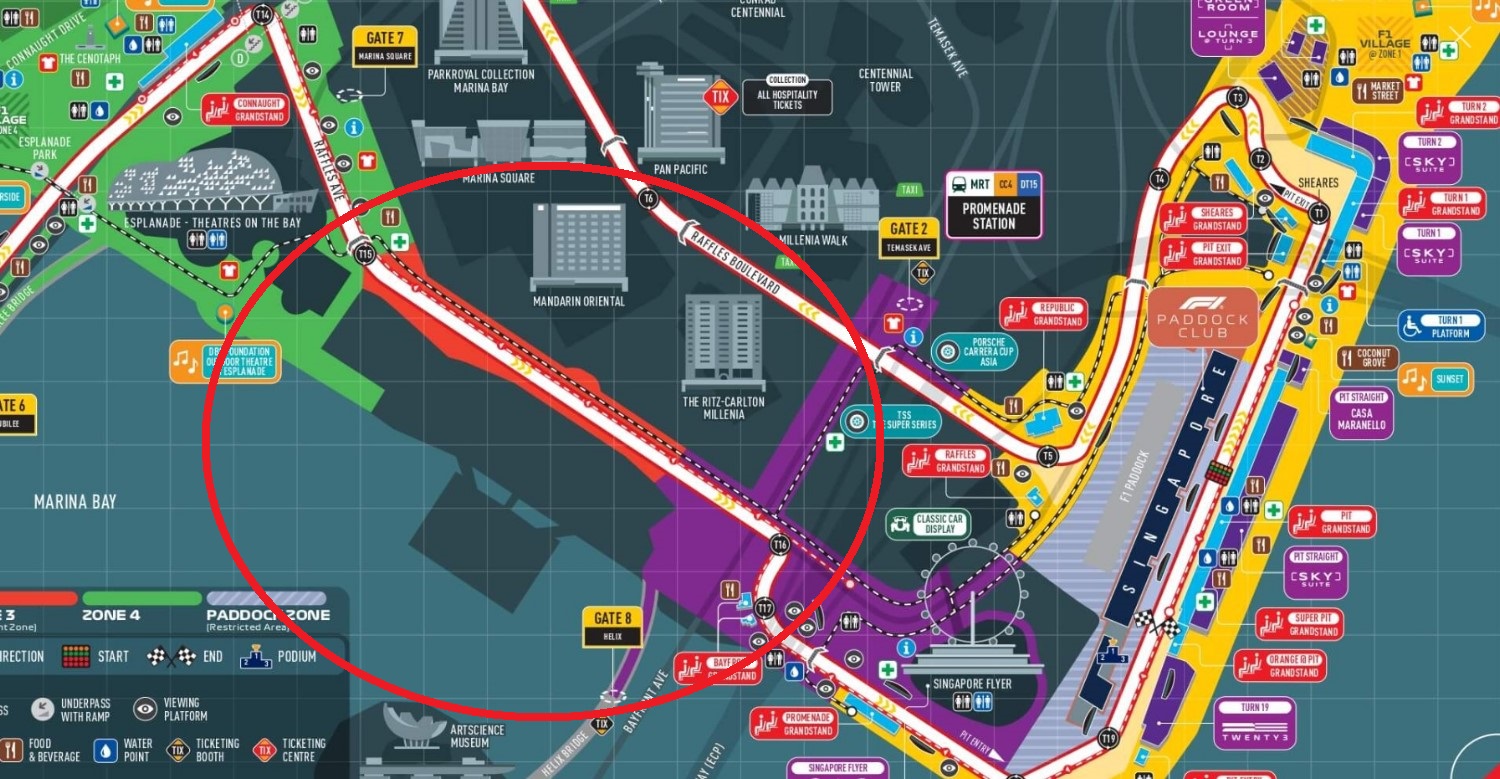
Singapore is a special race for the world of Formula One, too. It’s a peculiar one, a race in which to juggle European times on Southeast Asian soil; a race of late wake-ups, even later bed times, heat and humidity. But far from being displeasing, these elements all make Singapore a race like no other: you haven’t really fully been in the sport unless you have a fun Singapore story to share
The bumpy circuit, located in the Marina Bay district, takes Formula 1 drivers past some of Singapore’s famous landmarks, including the National Gallery, the Esplanade Concert Hall, and Singapore Flyer. The floodlit architecture provides a stunning backdrop to one of Formula 1’s most challenging events.
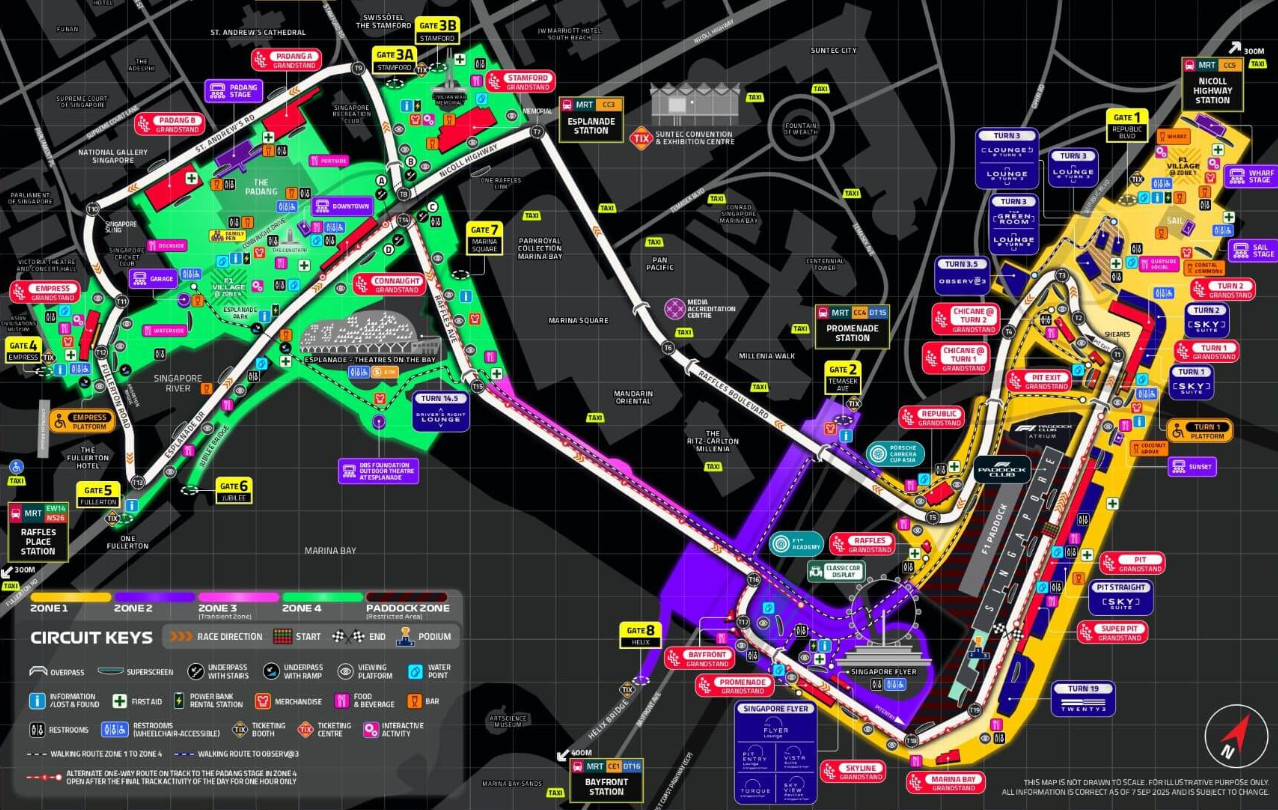
As with all street circuits, the slightest mistake in Singapore comes at a high price, given there are very few run-off areas and running a fraction off-line can see you in the barriers. Therefore, the Safety Car is a common sight here, especially as it takes quite a while to remove a stricken car from the track. There are a couple of factors that make the one-stop the only valid strategy: firstly, the time lost for a tire change pit stop is around 28 seconds, partly because the pit lane speed limit is reduced to 60 km/h and secondly, overtaking on this track is definitely complicated. A two-stop need only be considered in the event of the race being neutralized.
2025 F1 Drivers World Championship Points Situation
Here’s a breakdown:
Current Standings (Post-Azerbaijan GP, September 2025)
– Oscar Piastri (McLaren): 324 points
– Lando Norris (McLaren): 293 points
– Max Verstappen (Red Bull): 255 points
Verstappen trails Piastri by 69 points and Norris by 38 points.
Points Available
– 7 Grands Prix: Each race offers 25 points for a win, totaling 7 × 25 = 175 points.
– 3 Sprint Races: Each sprint offers 8 points for a win, totaling 3 × 8 = 24 points.
– Total Points Available: 175 + 24 = 199 points.
If Verstappen wins all remaining races and sprints, his maximum total would be:
– 255 (current) + 199 = 454 points
For Verstappen to overtake Piastri and Norris, he must close the points gap, which requires him to outperform both McLaren drivers consistently while hoping for setbacks (e.g., poor finishes, DNFs, or team rivalry).
The Singapore GP is pivotal. Verstappen’s recent wins in Monza and Baku show Red Bull’s improving form, but McLaren’s consistency makes them favorites. A Verstappen win in Singapore, paired with a McLaren mistake, could shrink the gap significantly.
Weather Forecast
The track is expected to remain dry during the race with high temperatures throughout the day and into the evening, but 75% humidity is forecast for the race start at 8pm (local time).
It will be 30 degrees Celsius from lights out, with just a 5% chance of rain affecting the race itself.
Singapore GP 2025 Weather Forecast (October 3-5) The Singapore Grand Prix weekend
|
Day
|
Sessions (Local Time)
|
High/Low Temp (°C)
|
Conditions
|
Rain Chance
|
Humidity
|
Notes for Racing
|
|---|---|---|---|---|---|---|
|
FP1 and FP2
Friday, Oct 3 |
FP1: 17:30-18:30 FP2: 21:00-22:00
|
31 / 26
|
Hot and humid; light clouds building to possible afternoon showers
|
40-50% (higher PM)
|
75-85%
|
Unpleasant heat for FP1; potential brief rain disrupting setup laps. Track temps could hit 35°C.
|
|
FP3 and Qualifying
Saturday, Oct 4 |
FP3: 14:30-15:30 Quali: 18:00-19:00
|
32 / 26
|
Partly sunny with increasing humidity; thundery showers possible late afternoon
|
30-40%
|
70-80%
|
Daytime heat peaks for FP3; evening quali likely dry but monitor for isolated storms.
|
|
Race
Sunday, Oct 5 |
Race: 20:00-21:30 (approx.)
|
29 / 26
|
Warm and humid evening; light clouds, low wind
|
20-25% (early day; <5% race time)
|
75-80%
|
Dry conditions expected under the lights—ideal for the full 62 laps. Feels like 37°C; hydration critical.
|
These forecasts indicate a physically demanding weekend for drivers and teams, with the usual emphasis on cooling strategies. Rain could add excitement if it hits earlier sessions, but the race itself looks set for a straightforward night battle. Updates may evolve closer to the event.
Fact File: Singapore Grand Prix Summarized Highlights
- There have been 15 editions of the Singapore Grand Prix to date and in ten of them, or two thirds, the winner has started from pole position. It shows just how important is qualifying, especially if a comparison is made with Monaco where 46.48% of the races have been won from pole. Only in the very first year in 2008, has the winner come from a position lower than fifth. Fernando Alonso started from 15th, but that race featured a completely chaotic sequence of events.The most successful driver in Singapore is Sebastian Vettel with five wins, followed by Lewis Hamilton on four. Seven drivers have shared all the wins here and four of them will be on track this weekend. Unusually, Max Verstappen is not one of them, as he is yet to break his duck at Marina Bay. Not only has he never won, he has never taken pole, although he has made it to the podium on three occasions. Of the teams, Mercedes, Ferrari and Red Bull lead the way on four wins apiece. When it comes to pole positions, Vettel and Hamilton top the table on four, with Ferrari the clear leader among the teams with seven. The German driver also has the most podium finishes on eight, ahead of Hamilton on seven and Alonso on five. Red Bull leads the teams
- Track evolution is incredibly high in Singapore, given that it is a street circuit. The surface can ramp up by as much as three seconds between FP1 on Friday and Qualifying on Saturday evening.
- In 2023, the circuit length was reduced from 5.063 km to 4.928 km and the number of laps of the Grand Prix increased from 61 to 62. Lap times were reduced by roughly 10 seconds due to the changes.
- The new layout was beneficial for the tyres; previously, they would begin to overheat towards the end of the lap, but the removal of four 90-degree corners helped them stay closer to the optimum operating window.
- Track evolution is incredibly high in Singapore, given that it is a street circuit. The surface can ramp up by as much as three seconds between FP1 on Friday and Qualifying on Saturday evening.
- The Singapore Grand prix is one of the most physically demanding races of the season. The intense humidity, warm temperatures, combined with the stop/start nature of the track, make it very challenging.
- Due to these factors, drivers can lose around 5kg of weight during the race through sweating alone.
- That stop/start nature, with a requirement for constant re-acceleration, ensures the circuit has one of the biggest fuel effects of the year. In simple terms, that mean the amount of time you lose each lap is higher for every kilogram of extra fuel in the car.
- Owing to the large amount of time spent in corners, just over 50% of lap time is spent at full throttle – only Monaco and the Autódromo Hermanos Rodríguez in Mexico have lower amounts.
- The track is also very bumpy. That adds to the stress that the drivers and cars are put through – that is particularly true with these new generation cars that run lower to the ground.
- With a speed limit of 60 km/h, and a layout that feeds in at turn two, the total pitlane time is the highest of the season at 25 seconds.
- Marina Bay is one of two circuits on the calendar to have a 60 km/h pitlane speed limit, owing to its tight nature. The other is Monaco.
- Being a street track, it is no surprise that between 2008 and 2024 all 14 Singapore Grands Prix featured at least one Safety Car deployment.
Heat and Humidity Aston Martin’s Andy Stevenson
From Baku’s Caspian Sea shoreline to Singapore’s spectacular Marina Bay. Ahead of the second leg of F1’s street race double-header, Aston Martin Aramco Sporting Director Andy Stevenson talks time zones, intense heat and humidity, and one of the most demanding racetracks in the world as he provides the lowdown on how the team will navigate the Singapore Grand Prix.
Singapore is unique as the paddock operates on a European time zone, despite local time being GMT+8. How does the team contend with this?
“You have to be very focused on the weekend schedule and ignore what the local time is. If you live on Singapore time and still work to the session times you’ll struggle.
“This year will be a little bit different to the past because we’re coming straight from Baku and we’ve already had a time change of three hours. In previous years, we’ve gone straight from the UK to Singapore and we’ve had a couple of days where people have adapted to the Singapore time zone and then had to flip back to Europe very quickly.
“It’s all about being disciplined. It’s all about making sure you get enough rest and it’s about eating at the right times. It’s very easy to fall into having lunch at lunchtime in Singapore when really you should be having breakfast. With the aid of the catering team, we make sure that we put meal times in the correct slots and that we’re serving the correct foods. We’re trying to trick the body into thinking that nighttime is daytime.”
Another challenge of Singapore is the heat and humidity. How do you and the team combat that?
“Acclimatization is key. You’ve got to go outside and get used to the heat and humidity – don’t sit in air conditioning all day. Singapore’s going to be hot, so expect it to be hot. Don’t think, ‘I’ll try and keep myself cool or tell my body that it’s not hot.’ The more you accept it, the better you deal with it.
“The most crucial thing is taking on enough liquid. You’ve got to make sure that you keep yourself hydrated and if you stop sweating, there’s something wrong.
“I don’t suffer with the heat much but it’s different for everybody, which over the years we’ve learned through bringing in professional doctors and physios via Formula Medicine.
“Some people’s bodies are just better at adapting than others so as a team we’ve got to look out for one another.
“Our team doctor, Rahul Chotai, will be checking in all the time, and I’ll do the same—I’m constantly watching to make sure that everybody is alert and still feeling fit and healthy. We have some busy days in Singapore and it’s very important to look out for the welfare for everybody.”
This race weekend comes immediately after the previous round in Azerbaijan. Has that created different challenges compared to travelling straight to Singapore from the UK?
“Double-headers are tough, even if you reduce the travel between the Grands Prix , but we have introduced systems and more resources to make the transition more efficient, so it’s not been much of an issue.
“Our primary focus is performance on track; we don’t want to be burning everybody out moving tons of equipment around; we need them to be focused on their job.
“We’ve got a great team and we have a lot of processes in place to try to make things as smooth as possible, so going from Azerbaijan or from the UK doesn’t matter too much, as we’re always prepared.”
How will the team fare on the streets of Singapore this weekend?
“There are such fine margins at the moment. What we have, generally speaking, is a fantastic championship. F1 has finally got what everyone has wanted for a long time with different cars being able to win but, unfortunately, we’re toward the back of that group of cars at the moment.
“It’s so competitive; Fernando was less than a tenth behind Lewis Hamilton’s Mercedes in Qualifying in Baku, and that car won a race not long ago.
“We’re around fifth-fastest wherever we go and it’s probably going to be similar in Singapore but, as we saw in Azerbaijan, if we execute everything well we can be ready to pick up extra points from any incidents ahead.”
After Singapore there are four weeks without a Grand Prix. Is this gap in the calendar an important opportunity to recharge before the final flyaway rounds of the season? What will you be doing in the break?
“We’ve always got work to do and we’re always trying to improve, so we can always make use of anybody who wants to come to work! The gap in the calendar does give the race team the opportunity to take some holiday and draw a breath, though.
“That opportunity isn’t there for everybody because there’s a lot of work that still needs doing, and I’m looking forward to having some time when I can focus on longer-term projects and tasks.
“For much of the season we’re going from race to race so having that little break in the schedule is great for me to catch up on things and do some planning for next season.
“I think the break will be good for everybody, whether they get time to have a holiday or just a break from traveling, because the final part of the season is going to be really busy with two triple-headers and three Sprint events.
“Having said that, after a very short time away from the circuit I’m always itching to get back to the track. I can’t wait to head to Austin next month for the United States Grand Prix.”
Last 10 winners of the F1 Singapore GP
| 2014 Singapore GP: | Lewis Hamilton (Mercedes) |
| 2015 Singapore GP: | Sebastian Vettel (Ferrari) |
| 2016 Singapore GP: | Nico Rosberg (Mercedes) |
| 2017 Singapore GP: | Lewis Hamilton (Mercedes) |
| 2018 Singapore GP: | Lewis Hamilton (Mercedes) |
| 2019 Singapore GP: | Sebastian Vettel (Ferrari) |
| 2022 Singapore GP: | Sergio Perez (Red Bull) |
| 2023 Singapore GP: | Carlos Sainz (Ferrari) |
| 2024 Singapore GP: | Lando Norris (McLaren) |
What to watch for
Race interruptions: Being a street track, it is perhaps no surprise that all 14 of the previous Singapore Grands Prix have featured at least one Safety Car deployment. In the last six editions, we have seen 11 Safety Car deployments.
Overtaking: This is one of the hardest venues at which to overtake, second only to Monaco. With an alternative layout this year, with Turns 16-19 removed and replaced by a straight, there might be an increased number of overtakes in the Grand Prix. Historically, the first DRS zone has been the prime passing place.
Strategy: A one-stop strategy is expected to be the fastest one at Marina Bay, given the pit loss of 27 seconds – the highest of any circuit on the calendar thanks to the 60km/h speed limit and tricky pit entry. Pirelli is bringing the softest trio of compounds to Singapore for maximum grip on a twisty and demanding track.
Unlocking the Lap
Marina Bay is one of the twistiest circuits on the calendar; its 4.940 kilometers featuring 19 corners since modifications made in 2023 reduced the number from 23. This was done by putting a 400 meter straight into the section after turn 16. The track surface has the same characteristics as the neighboring city streets, with very low roughness, while the many road markings can pose an additional hazard in the rain. There is not much in the way of run-off areas and the barriers are very close, even though, in parts the track is actually quite wide.
There are four DRS zones, but as mentioned, overtaking is generally a rarity. The increase in the pit lane speed limit from 60 to 80 km/h should have a significant effect on strategy, with a one-stop almost obligatory.
Variables that are hard to predict include neutralizations and the weather, which at the Equator is highly changeable. Thunderstorms are far from uncommon, and the rain can wash away the rubber laid down, which resets track conditions, thus influencing tire performance.
Pirelli Tires
Pirelli has made no changes since last year for the dry weather compounds at the Marina Bay circuit, with the C3 as Hard, the C4 as Medium and the C5 as Soft. Although there exists the softer still C6, when the compounds for the second part of the season were announced during the Hungarian Grand Prix weekend, evaluations carried out before the summer break ruled out the softest tire in the 2025 range, because the forces exerted on the tyres and the high temperatures at this event might have created some overheating issues. In fact, in this race, thermal stress is the main cause of tire performance degradation.
Medium and Hard will clearly be the compounds of choice for the race, but the Soft could come into play for any driver wanting to make the most of its extra grip at the start, or if there’s a Safety Car period towards the end of the race. Modifications made to the track layout a couple of years ago mean overtaking is a bit easier, although obviously, it is still rather complicated to get past another car. Therefore, being able to call on the big performance difference between relatively new Softs and Mediums or Hards that have done many laps, could be a factor to bear in mind.
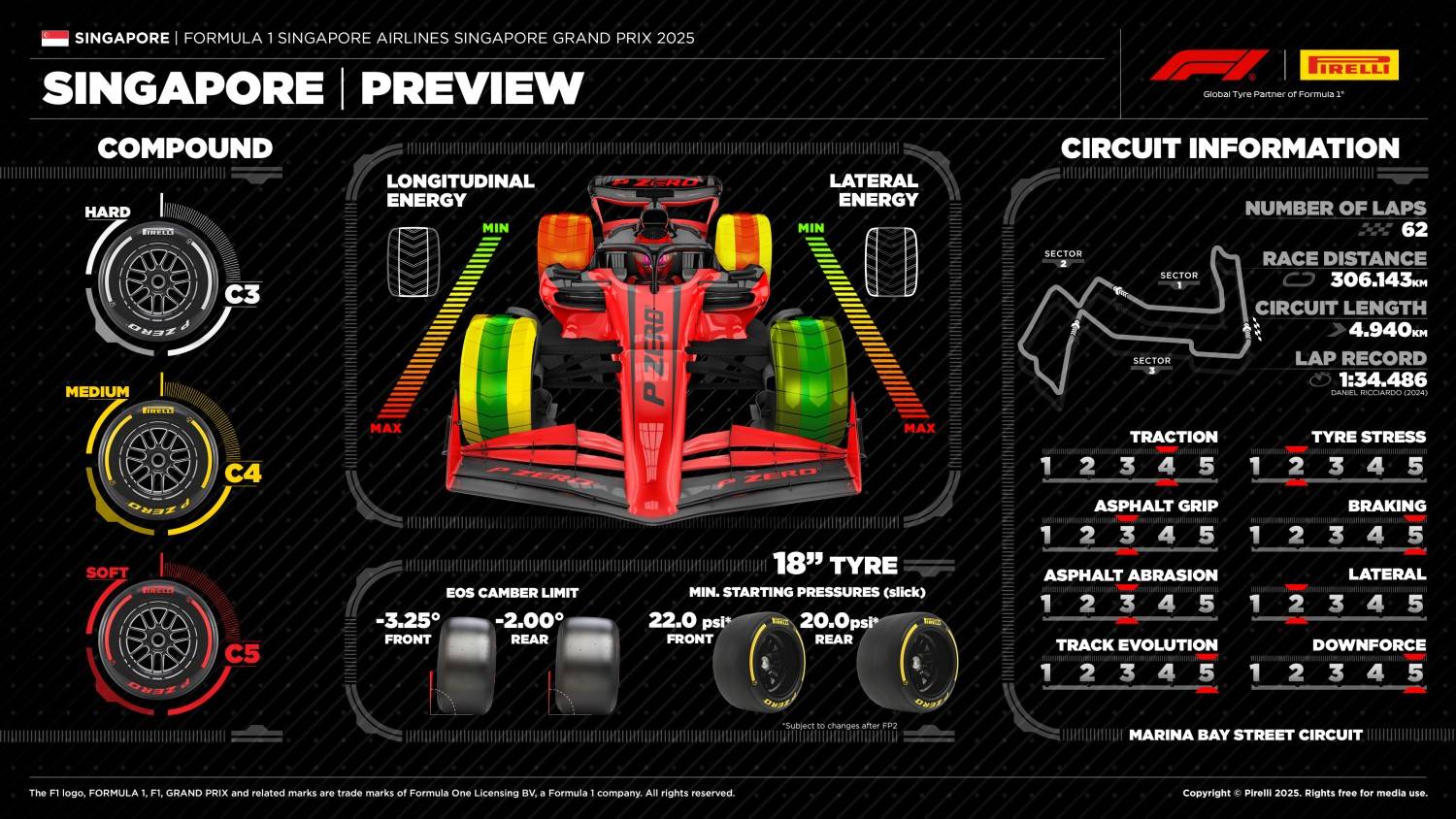
In 2024
The Medium was the most popular choice for the start with 14 drivers going for the C4, while four went with the Hard and two the Soft. The flexibility of the Medium meant there were several possibilities in terms of when to make the only tire change, as the one-stop strategy was, as usual, clearly the fastest choice. Traffic and tire management allowed drivers to extend the opening stint, in the most extreme case to 49 laps. Last year’s race was one of the very few at this track not to have required the safety car to put in an appearance.
